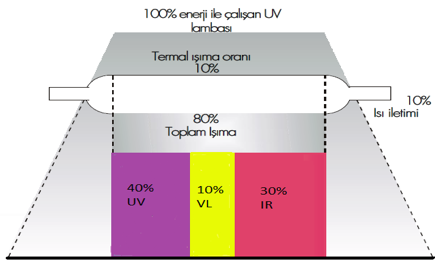UV LED TECHNOLOGY IN PRINTING TECHNOLOGIES
We use UV light cured inks in our screen and pad printing processes, especially for many customers in the white goods industry. UV Inks have many advantages compared to solvent-based inks due to ease of printing, rapid drying, not being affected by environmental conditions such as temperature, especially abrasion resistance, compliance with white goods test standards and low ink consumption. We can say that in the future, they will replace the conventional solvent-based inks. Many ink manufacturers continue to work on developing UV-based ink assortments.
Despite the many benefits of UV applications, one of the biggest disadvantage is the need for mercury UV lamps in order to finish the drying/curing. The initial investment costs of this type of lamps are high and their maintenance costs are very high as well, but their lifetimes is very short, they require very high electrical energy and produce very much of waste gas. Studies indicate that ultraviolet light emitting diodes (UV-LED) will eliminate the disadvantages of mercury lamps.

We have started to use the UV-LED system in pilot applications, which we developed in our R&D center. Compared to conventional UV lamps, new generation UV LED lamps will eliminate the disadvantages of conventional UV systems with their energy saving, time saving, ease of installation, zero maintenance costs and environmental features.
If we need to specify the advantages of UV-LED System in general:
• It provides a safer printing environment by eliminating the effect of ozone, mercury and heat formed during printing.
• It saves energy consumed by min. P ratio.
• It provides fast drying during the process.
• It has low ink consumption.
• It is not affected by environmental conditions.
• Unless conventional UV lamps are cooled, temperature values reach up to 1000 ˚C. UV LED technology eliminates the risks of high temperatures and cooling costs.
• UV LED technology, which has a 10 times longer lifetime than traditional UV lamps, increases efficiency by eliminating the risks that may arise during lamp replacement.
Some of the traditional UV and LED UV basic features are compared below.
| Traditional UV | LED UV | |
| Lamp Lifetime | 1000 hours | >20.000 |
| Environmental Impact | Mercury, ozone gas waste | No mercury, no ozone |
| Need for Maintenance | Lamp maintenance, reflector ecleaning | Maintenance free |
| Energy Need | High | Low(>`) |
| Heat Emission | 1000 ˚C | 60 ˚C |
| Turning on/off speed | 5 minutes | Instant |
| Wavelength | 100-1800 nm | 365-415 nm |
With the efforts of the Alpplas R&D Center, we’re planning to produce 407 nm wavelength and 100 Watt power UV LED lamps and to replace the conventional lamps used in internal processes with new lamps within a program. Due to the cost advantages obtained with these applications, we offer options to increase the competitiveness of our customers without sacrificing quality. In addition, we also provide benefits for our employees, such as reduced waste levels in the working environment and higher temperature comfort levels. You can contact our expert team to get to know the advantages of UV LED printing technologies that will take even further the conventional printing techniques we have used in our processes for 30 years.
We continue our R&D project in order to spread these pilot applications among our projects. In current development project, 48 UV LED which has a power of about 100 watts and a wavelength of 407 nm, will be used as an alternative to conventional mercury UV lamp that we frequently use in our internal processes.
Due to the cost advantages obtained with these applications, we offer options to increase the competitiveness of our customers without sacrificing quality. In addition, we also provide benefits for our employees, such as reduced waste levels in the working environment and higher temperature comfort levels.
You can contact our expert team to take advantage of our new generation UV LED printing applications, which can be an alternative to traditional solvent drying inks by adding UV LEDs within the conventional printing techniques we have used in our processes for 30 years.
